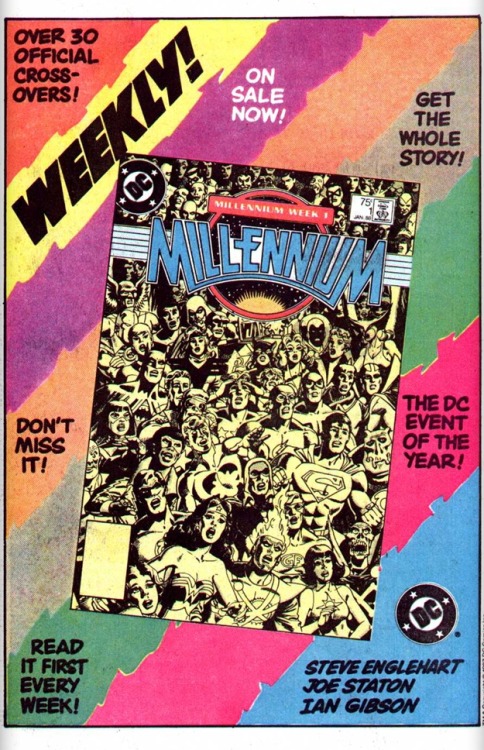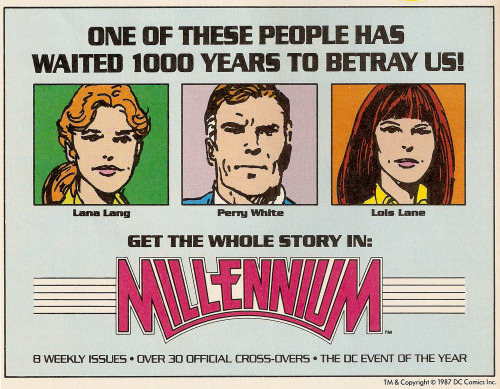Millennium cross-over eventMillennium was DC’s third inter-company cross-over (preceded by
Millennium cross-over eventMillennium was DC’s third inter-company cross-over (preceded by Crisis on Infinite Earths and LEGENDS, respectively). If the goal of Crisis on Infinite Earths was to sort out its continuity issues and the goal of LEGENDS was to re-establish the DCU, then I’d theorize that the goal of Millennium was to flesh out the characters and relationships within the DC universe. The entire 56-issue Millennium event took place over a two month publication period (Crisis took about a year and LEGENDS took 7 to 8 months). Millennium itself was an eight-issue mini-series released on a weekly basis (each issue labelled as ‘week 1’, 'week 2’, etc…) that acted as a overview of the event - readers were encouraged to read all of the tie-in issues that ran through the DC titles to understand what was going on between the weekly installments of Millennium. This cross-over event was all-encompassing and seemed to involve all of the most popular DC titles at the time (ex: all Batman titles, all Superman titles, Flash, Wonder Woman, whatever series Green Lantern was starring in, Legion of Super-Heroes, etc). Mega cross-overs involving all titles were still a relatively new gimmick at this point in time and DC was still testing the waters. The Millennium mini-series was handled by the creative team of Steve Englehart, Joe Staton and Ian Gibson. Prior to being assigned Millennium, Englehart and Staton had raised the sales of tepid selling Green Lantern v2 to heights previously unseen in the publication’s history. Actually, the whole concept of Millennium was inspired by a plot device Englehart had used in Green Lantern v2 #200 (1986) in which the Guardians task the Green Lantern Corps to protect Earth because it would be an ideal breeding ground for immortals in the next thousand years. The Millennium storyline was centered around the Guardians of the Universe’s efforts to evolve human beings to the next level, and the Manhunters who were trying to oppose them. As it happens, Englehart co-created the Manhunters and introduced them to the DC Universe back in Justice League of America #140 (1977). The Guardians of the Universe (said to be originally modeled after David-Ben Gurion) were originally created by John Broome and Gil Kane, but it was Englehart who (while writing Green Lantern) had managed to tie the Guardians in with a mega cross-over event (going so far as to reveal the Guardians as the original cause of the Crisis) thus solidifying their involvement in all things cosmic in the DC Universe. [I remember hearing a rumor that editor Andy Helfer (who helped coordinate with the other DC writers while Englehart worked from his California home) retired from comics after this cross-over event due to all of the stress involved (he also edited the LEGENDS cross-over). However, I know that Helfer went on to edit several more DC titles before becoming editor of Paradox Press, so I don’t think there’s any truth to that rumor.]If one were to breakdown the plot of Millennium into 4 acts, they would be:Act 1: heroes discover there are traitors/Manhunters among themAct 2: heroes rally and attack Manhunters’ earth forcesAct 3: heroes attack Manhunters in spaceAct 4: heroes attack Manhunter HQ at center of worldIt was the first act that caused the biggest commotion with the writers at DC comics - not only were they mandated by the 'higher ups’ at DC to work the Millennium event into their storyline, but they also had to select a supporting character to be revealed as a Manhunter in disguise. As you can see in the above ads, the whole idea of who will be revealed as a traitor was a major part of the marketing campaign. To their credit, it was left up to the writers to decide who the traitor would be. Some writers really went out of their way to make their series work with Millennium (ex: John Byrne who seamlessly integrated the Millennium event into his 1988 World of Smallville Superman origin retcon mini-series, Roy Thomas who took the opportunity to retcon the origins of the Dan Richards and Paul Kirk Manhunters in a way that was consistent with the Millennium storyline, and Paul Levitz who probably received a lot of hate mail from fans when he revealed who the Manhunter in the Legion of Super-Heroes was), and other writers easily modified their story lines so that it had something to do with Millennium (ex: George Perez and his “Challenge of the Gods” in Wonder Woman, Mike Baron reveals the traitor in Flash in a way that would make logical sense in hindsight), while other writers seemed to glaze over it completely (ex: Keith Giffen’s Justice League International traitor is quickly replaced with a carbon-copy duplicate and has no effect on the series). A few characters appeared for the first time during these tie-ins, but were not directly involved with Millennium - these included G'Nort (Justice League International #10) and the post-Crisis Toyman (Superman #13). The Firestorm Millennium tie-ins mainly involved Firestorm dealing with the evolution of his powers.I previously mentioned that all of the major DC titles were involved in this cross-over, however a few were actually left out. These included:Swamp Thing, Vigilante and the Question (Because they were 'mature reader’ titles, and DC didn’t think it was wise to include them in a cross-over event that was targeted to general audience members. Yet The Spectre was included? Interesting.)The Teen Titans (At the time they were doing that 'direct edition/newsstand edition’ thing where one set of stories would have to be set 1 year in the future. Just a major continuity headache to figure out.)The Warlord (DC had promised fans that after LEGENDS they would never do another Warlord/DCU cross-over story due to negative fan reaction)Millennium led to the creation of two new spin-off titles in 1988: the New Guardians and John Ostrander’s the Manhunter. Likewise, Millennium saw the end of the Outsiders v1 and Booster Gold v1, but the sales on these books were already dwindling - so in essence Millennium was just a convenient plot device they could use to wrap things up. (Blue Beetle would also be cancelled shortly after his Millennium tie-in.)Another thing that Millennium is infamous for is featuring the first gay super hero in the DC universe. I say 'infamous’ because the character is so poorly-written and stereotypical that he may have set the gay movement back 10 years. Extraño was a Peruvian magician who was empowered by the Guardians and made to become a member of the New Guardians. Englehart was panned by the gay community for his portrayal of the offensively flamboyant character, often receiving mail that went along the lines of “I am gay and that character should in no way shape or form act as a reference of what a gay person is like”. You need to remember that Englehart (for whatever reason) was not allowed to come out and say the character was gay, so he had to push the theatrics to the extreme so that the readers could pick up on it. For all it’s worth, Englehart really tried to introduce a gay super-hero into DC comics.(more on this some other time)After Millennium, DC comics wanted to move Green Lantern to the new Action Comics weekly series (in an effort to generate interest in the new Action Comics format). Englehart and Staton declined, since they didn’t want to be confined to a 7-page weekly format. Green Lantern Corps (the book Englehart and Staton were working on) lasted a few more issues after Millennium and was then cancelled. I really enjoyed this cross-over event. Over time I have managed to find all 47 tie-in issues (discount bin hunting at comic book shops) and I absolutely do not regret it. This was the absolute BEST TIME EVER to read DC comics: we had John Ostrander’s Suicide Squad, Batman was teamed with Jason Todd Robin, the Superman books had just been rebooted by Byrne, Thomas was writing Young All-Stars AND Infinity Inc., Wally West Flash had just taken over Barry Allen’s title, Keith Giffen’s Justice League was at some of it’s best moments, George Perez’ Wonder Woman was just revving up and the Legion of Super-Heroes was going strong. DeMatteis’ new Dr Fate and Mike Grell’s Green Arrow even make a few appearances. I especially liked the Secret Origins tie-ins (re-explained and retconned numerous origins to characters in a way that seemed to flow effortlessly with Millennium and the new DCU) and Teen Titans Spotlight issues (which took the time to feature characters that didn’t really fit anywhere else but were important to the story regardless). I really like how this cross-over was able to incorporate a lot of elements from the Crisis on Infinite Earths while still bringing something new to the table. I didn’t get why DC decided to expose all of the Manhunter traitors in the first issue of Millennium - I think that had they let the suspense build up for longer the result could’ve been more entertaining. This event deals heavily with the idea of humanity evolving, which apparently is a theme Englehart likes to explore. Astute comic readers have drawn parallels between Millennium and Englehart’s Celestial Madonna storyline that ran in various Marvel comics’ Avengers books from 1974 to 1975.*Dan Richards was the alter-ego of a Quality Comics character called the Manhunter first introduced in 1942. Coincidentally, DC also had a character called the Manhunter (alter ego Paul Kirk) who debuted one month after Dan Richards did in 1942. DC bought the rights to the Dan Richards Manhunter in 1956 when Quality Comics went bankrupt. -- source link
#millennium#englehart#staton#homosexual#homosexuality#dc comics#crossover



